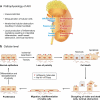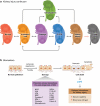Biomarkers of acute kidney injury
- PMID: 17937594
- PMCID: PMC2742480
- DOI: 10.1146/annurev.pharmtox.48.113006.094615
Biomarkers of acute kidney injury
Abstract
Acute kidney injury (AKI) is a common condition with a high risk of death. The standard metrics used to define and monitor the progression of AKI, such as serum creatinine and blood urea nitrogen levels, are insensitive, nonspecific, and change significantly only after significant kidney injury and then with a substantial time delay. This delay in diagnosis not only prevents timely patient management decisions, including administration of putative therapeutic agents, but also significantly affects the preclinical evaluation of toxicity thereby allowing potentially nephrotoxic drug candidates to pass the preclinical safety criteria only to be found to be clinically nephrotoxic with great human costs. Studies to establish effective therapies for AKI will be greatly facilitated by two factors: (a) development of sensitive, specific, and reliable biomarkers for early diagnosis/prognosis of AKI in preclinical and clinical studies, and (b) development and validation of high-throughput innovative technologies that allow rapid multiplexed detection of multiple markers at the bedside.
Figures


References
-
- Warnock DG. Towards a definition and classification of acute kidney injury. J. Am. Soc. Nephrol. 2005;16:3149–50. - PubMed
-
- Chertow GM, Lee J, Kuperman GJ, Burdick E, Horsky J, et al. Guided medication dosing for inpatients with renal insufficiency. JAMA. 2001;286:2839–44. - PubMed
-
- Liangos O, Wald R, O'Bell JW, Price L, Pereira BJ, Jaber BL. Epidemiology and outcomes of acute renal failure in hospitalized patients: a national survey. Clin. J. Am. Soc. Nephrol. 2006;1:43–51. - PubMed
-
- de Mendonca A, Vincent JL, Suter PM, Moreno R, Dearden NM, et al. Acute renal failure in the ICU: risk factors and outcome evaluated by the SOFA score. Intensive Care Med. 2000;26:915–21. - PubMed
Publication types
MeSH terms
Substances
Grants and funding
LinkOut - more resources
Full Text Sources
Other Literature Sources

